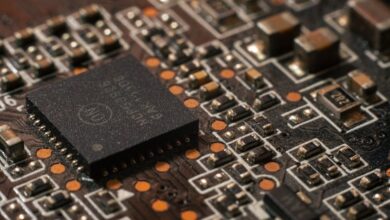TAG Heuer’s New Smartwatch Ditches Google’s Wear OS to Be Apple Friendly

TAG Heuer’s New Smartwatch Ditches Google’s Wear OS to Be Apple Friendly
Estimated Reading Time: 5 minutes
- TAG Heuer has transitioned from Google’s Wear OS to a proprietary operating system for its new luxury smartwatches.
- The new bespoke OS is “Made-for-Apple” certified, ensuring deep and seamless integration for iPhone users, while still maintaining Android compatibility.
- This strategic move provides TAG Heuer with greater control over user experience, design flexibility, and performance optimization, enabling a truly unique luxury offering.
- The shift sets a precedent in the luxury smartwatch market, emphasizing custom-tailored experiences and strong ecosystem integration as key differentiators.
- The Connected Calibre E5 promises enhanced performance, better battery life, and a refined user interface that aligns with TAG Heuer’s brand identity.
- TAG Heuer’s New Smartwatch Ditches Google’s Wear OS to Be Apple Friendly
- The Strategic Pivot: Why TAG Heuer Left Wear OS
- A Bespoke Experience: What the New OS Offers
- The “Made-for-Apple” Advantage: Seamless Integration
- Real-World Example
- More Than Just a Watch: The Future of Luxury Smartwatches
- Actionable Steps
- Conclusion
- Frequently Asked Questions
TAG Heuer’s New Smartwatch Ditches Google’s Wear OS to Be Apple Friendly
In a bold move that redefines the intersection of luxury timepieces and cutting-edge technology, TAG Heuer has unveiled its latest generation of smartwatches with a significant strategic shift. The iconic Swiss watchmaker, renowned for its precision and heritage, is charting a new course by moving away from Google’s Wear OS, opting instead for a proprietary operating system meticulously crafted to offer unparalleled integration, especially for Apple users.
This decision marks a pivotal moment in the luxury smartwatch segment, indicating a growing desire among high-end brands to exert greater control over the user experience and cater more directly to the preferences of their discerning clientele. By forging its own path, TAG Heuer aims to elevate its connected offerings beyond generic smart functions into a realm of bespoke luxury that feels truly intuitive and integrated.
The Strategic Pivot: Why TAG Heuer Left Wear OS
TAG Heuer’s history with smartwatches began with Wear OS (formerly Android Wear), a platform that offered a convenient entry point into the connected watch market. However, as the ecosystem matured, so did the brand’s ambitions. Relying on a third-party operating system, while providing broad compatibility, often meant compromises in terms of design flexibility, performance optimization, and the ability to deliver a truly unique brand experience.
The competitive landscape, particularly the dominance of Apple in the premium wearables sector, likely played a significant role in this re-evaluation. For a luxury brand like TAG Heuer, differentiating itself through superior user experience and seamless integration, rather than simply offering a luxury shell around a standard OS, became paramount. This pivot underscores a drive to provide an exclusive digital identity that mirrors the exclusivity of its mechanical counterparts.
A Bespoke Experience: What the New OS Offers
The new direction for TAG Heuer’s smartwatches is centered around a custom-built operating system designed from the ground up. This allows the brand to fine-tune every aspect of the watch’s functionality, from power efficiency to user interface design, ensuring a cohesive and premium feel that aligns with TAG Heuer’s legacy of excellence. Such a tailored approach provides the agility to implement features specific to the luxury market, focusing on refinement rather than broad-stroke functionality.
This commitment to a personalized digital core is captured perfectly: “The Connected Calibre E5 runs a bespoke OS. It still works with Android—but it now gets that coveted Made-for-Apple certification.” This statement highlights the dual compatibility of the new system, ensuring Android users aren’t left behind, while unequivocally signaling a strong embrace of the Apple ecosystem. The bespoke OS promises faster performance, enhanced battery life, and a user interface that is distinctly TAG Heuer, tailored for both form and function.
The “Made-for-Apple” Advantage: Seamless Integration
The “Made-for-Apple” certification is more than just a badge; it’s a testament to a deep level of hardware and software integration that significantly enhances the user experience for iPhone owners. This certification indicates that the TAG Heuer smartwatch meets Apple’s stringent performance and compatibility standards, ensuring reliable connectivity, optimized battery consumption, and seamless interaction with Apple’s ecosystem of services and applications.
For an iPhone user, this means effortless pairing, robust notification management, and deep integration with services like Apple Health and other iOS apps. Unlike generic Bluetooth connections, a “Made-for-Apple” certified device is designed to work in perfect harmony with your iPhone, offering a fluid and intuitive experience that feels like a natural extension of your phone, rather than a separate device. This level of synergy addresses a key pain point for luxury consumers who expect their high-end devices to work flawlessly together.
Real-World Example:
Imagine Sarah, an avid iPhone user who values both style and seamless connectivity. With her previous smartwatch, she often experienced notification delays or struggled to sync her fitness data reliably with Apple Health. Now, with the TAG Heuer Connected Calibre E5, her watch instantly mirrors her iPhone’s alerts, her run data flows directly into Apple Health without a hitch, and controlling her music through her watch feels as native as using AirPods. This level of dependable, integrated performance elevates her daily experience, justifying the premium investment.
More Than Just a Watch: The Future of Luxury Smartwatches
TAG Heuer’s strategic shift sets a precedent for the luxury smartwatch market. It suggests a future where high-end brands might increasingly prioritize custom-tailored experiences over generic platforms, seeking to offer unique value propositions that resonate with their specific audience. This move could inspire other luxury watchmakers to develop their own bespoke ecosystems, fostering innovation and greater differentiation within the connected wearables space.
By taking control of its software destiny, TAG Heuer is positioning itself not just as a watchmaker, but as a luxury technology innovator. The brand understands that true luxury in the digital age is about seamless performance, personalized functionality, and an exclusive experience that transcends mere features. This forward-thinking approach ensures that the TAG Heuer smartwatch remains a desirable object of both style and sophisticated engineering.
Actionable Steps
-
Evaluate Your Ecosystem Needs:
For potential smartwatch buyers: Before investing, consider your primary smartphone’s ecosystem. If you’re an iPhone user, prioritize smartwatches with “Made-for-Apple” certification or deep iOS integration for the most fluid experience. Android users should ensure robust compatibility with their device. Matching your tech ecosystem will significantly enhance satisfaction.
-
Prioritize Seamless Connectivity:
For luxury brands in tech: Don’t just tick compatibility boxes. True value lies in deep, seamless integration. Invest in developing bespoke solutions or forging strong partnerships that ensure your product feels like a native extension of the user’s primary device, rather than an add-on. This enhances user loyalty and perceived quality.
-
Look Beyond Standard Platforms:
For innovators and product developers: While established platforms offer convenience, a bespoke operating system can provide unparalleled control over user experience, performance, and brand identity. If differentiation and a premium feel are paramount, explore the benefits of custom software development to create truly unique and optimized products.
Conclusion
TAG Heuer’s decision to move away from Google’s Wear OS and embrace a bespoke, Apple-friendly operating system for its new Connected Calibre E5 smartwatch is a defining moment. It underscores a clear understanding that in the luxury market, control over the user experience and seamless integration are paramount. This strategic pivot not only enhances the brand’s offering for iPhone users but also positions TAG Heuer as a pioneering force in the evolving landscape of high-end connected wearables.
This move reflects a broader trend of brands seeking greater autonomy and customization in their technological products. By blending traditional Swiss craftsmanship with tailored digital innovation, TAG Heuer is not just selling a smartwatch; it’s offering an exclusive, integrated lifestyle experience. The future of luxury smartwatches will undoubtedly be shaped by such deliberate and user-centric decisions.
What are your thoughts on TAG Heuer’s strategic shift towards an Apple-friendly bespoke OS? Do you believe other luxury brands will follow suit? Share your insights in the comments below!
Frequently Asked Questions
Q1: Why did TAG Heuer abandon Google’s Wear OS?
TAG Heuer shifted from Wear OS to gain greater control over the user experience, design flexibility, and performance optimization. This move allows them to deliver a truly unique and luxurious brand experience, tailored to their high-end clientele, particularly focusing on seamless integration with Apple’s ecosystem.
Q2: What does “Made-for-Apple” certification mean for the new smartwatch?
The “Made-for-Apple” certification signifies that the TAG Heuer smartwatch meets Apple’s strict standards for performance and compatibility. For iPhone users, this translates to effortless pairing, robust notification management, optimized battery life, and deep integration with iOS apps and services like Apple Health, providing a fluid and intuitive experience.
Q3: Is the new TAG Heuer smartwatch still compatible with Android phones?
Yes, despite the strong emphasis on “Made-for-Apple” certification, TAG Heuer has confirmed that its new bespoke operating system (Connected Calibre E5) still works with Android devices, ensuring compatibility for a broader user base.
Q4: How does a bespoke OS benefit the user?
A custom-built operating system allows TAG Heuer to fine-tune every aspect of the watch’s functionality, leading to faster performance, enhanced battery life, and a user interface that perfectly aligns with the brand’s luxury aesthetic. This tailored approach ensures a cohesive, premium, and refined user experience distinct from generic smartwatch platforms.
Q5: Will other luxury brands follow TAG Heuer’s strategy?
TAG Heuer’s move sets a significant precedent in the luxury smartwatch market. It is highly probable that other high-end brands might increasingly consider developing their own bespoke ecosystems or prioritizing deep integration with specific smartphone platforms (like Apple’s) to offer unique value propositions and differentiate themselves in the competitive wearables space.





